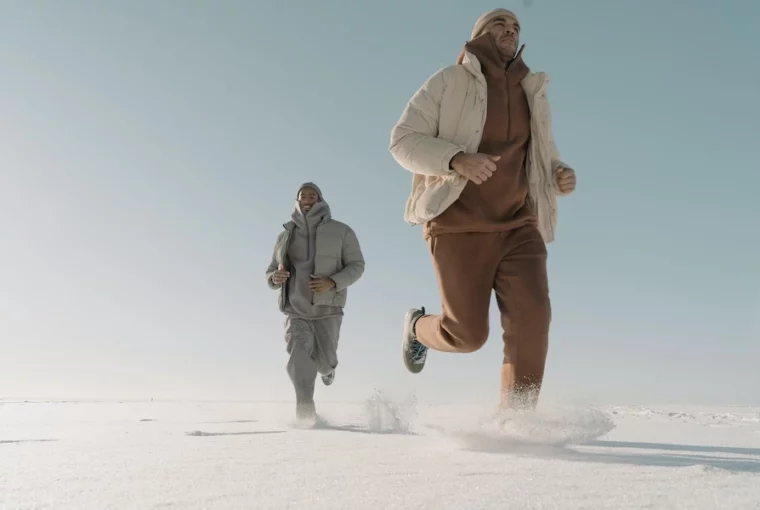Just because it’s winter doesn’t mean that you should give up on your favorite time of the day— when you get to go on a long run and feel like you’re all ready to take on the rest of the day.
Running is one activity that most people seem to enjoy doing all year round, because it isn’t as physically exhaustive as weight lifting and leaves you feeling extremely fresh and alive soon after you’re done with a good run. However, it can feel a little tricky to continue your running routine during the winter season, especially when it’s cold and wet outside all morning.
But don’t let this hold you back. If you really want to go on a run all through winter, there are numerous precautions you can take to make sure that you never get affected by the cold. Running during winter can be extremely rewarding, because you get more exercise than you would throughout the rest of the day, especially when the weather forces you to be lethargic and not as active as always.
What’s more, if you generally prefer running barefoot, then there are ways to continue doing the same even during winter, despite what the weather looks like outside.
In this blog, we’re going to be talking about some of the best tips and tricks that will help you during your winter workouts and runs, so you don’t let sweater weather get in the way of your daily routine.
Let’s get started!
1. Use Barefoot Running Shoes During Winter
While many people get used to running barefoot and never turn back from that, it isn’t always for everybody. Running barefoot has proven to show good results, but where you’re running and what you’re running on play a role in this decision as well. However, just because you can’t run barefoot doesn’t mean that you can’t enjoy the benefits that come with it as well.
Barefoot running shoes are all the hype right now – because these shoes protect your feet, while also being so light and flexible that they feel like they aren’t there. Over the years, research has proven that walking and running barefoot are extremely beneficial for a number of health reasons, especially posture.
On the same note, running barefoot has also proven to help athletes run better, especially when they’re sprinting. If you generally run barefoot but aren’t sure about how you’re going to do so in winter, then these shoes are perfect for you.
Not only will they feel like there’s nothing on, but they’ll also prevent your feet from freezing in the cold or getting blistered by the sudden change in temperature. If you’d like to know more about them, you can check out some of the top barefoot running shoes that are listed at Runners Athletics to figure out which type will suit you best.
2. Finish Your Warm Up Before You Head Out To The Snow
You might be used to heading out first before you begin warming up, but this may not be ideal, especially if you’re trying to get your feet used to the snow or cold so you can run barefoot during the winter.
One way to help do this is by finishing up your core warm up before you head out – this will ensure that your body is pumping heat to keep you warm as you expose yourself to the sudden chillness. If you don’t warm up before heading out in the snow, there’s a high chance that you may start freezing and shivering, which will prevent you from having an effective workout and running session.
Additionally, the coldness of the pavement or snow won’t affect your feet terribly if your core is already warm, as opposed to otherwise.
3. Wear The Right Winter Gear
Even if you’ve got your feet protected with the right barefoot shoes, you still won’t be able to have an effective workout session unless the rest of your body is properly protected too. For instance, you need to be able to spend a considerable amount of time outside to be able to have an effective workout session, but if your core is freezing as soon as you step out, then that may reduce the amount of time you’ll be able to be out there in the cold.
Make sure you’re wearing the right thermals that are warm yet light, so that your body and core remain warm. It’s also a good idea to keep your hands, legs, and head warm as well, if you’re only going out for a run.
4. Have An Ice Water Bath Before You Begin
This may not be for everyone, but one effective way to increase your tolerance towards the cold weather is by taking an ice water bath every morning before you begin your workout session. During the winter, even regular water is going to feel ice cold, so you needn’t go through the extra trouble of adding ice to your water.
All you need to do is pour this all over your body for a few minutes and then completely dry yourself up before you start wearing your winter running gear. As the weeks pass, you’ll eventually notice a difference in your tolerance levels towards the cold. There are many other benefits that come with having an ice water bath, which includes feeling extremely refreshed and energized.
5. Once You Start Your Workout, Don’t Stop Moving
Once you’re out there in the cold and you begin your workout, make sure that you don’t stop moving and keep your body active. This way, you can ensure that your core continues to feel warm from your warm up session and will keep you active till the end of your workout.
However, if you slow down or stop moving, you’ll immediately feel the dip in temperature, after which it will take extra energy for you to warm up your core and body again. Instead, try to keep yourself active while you’re out there in the cold and immediately head home if you feel like you’ve hit your target workout timing for the day.




